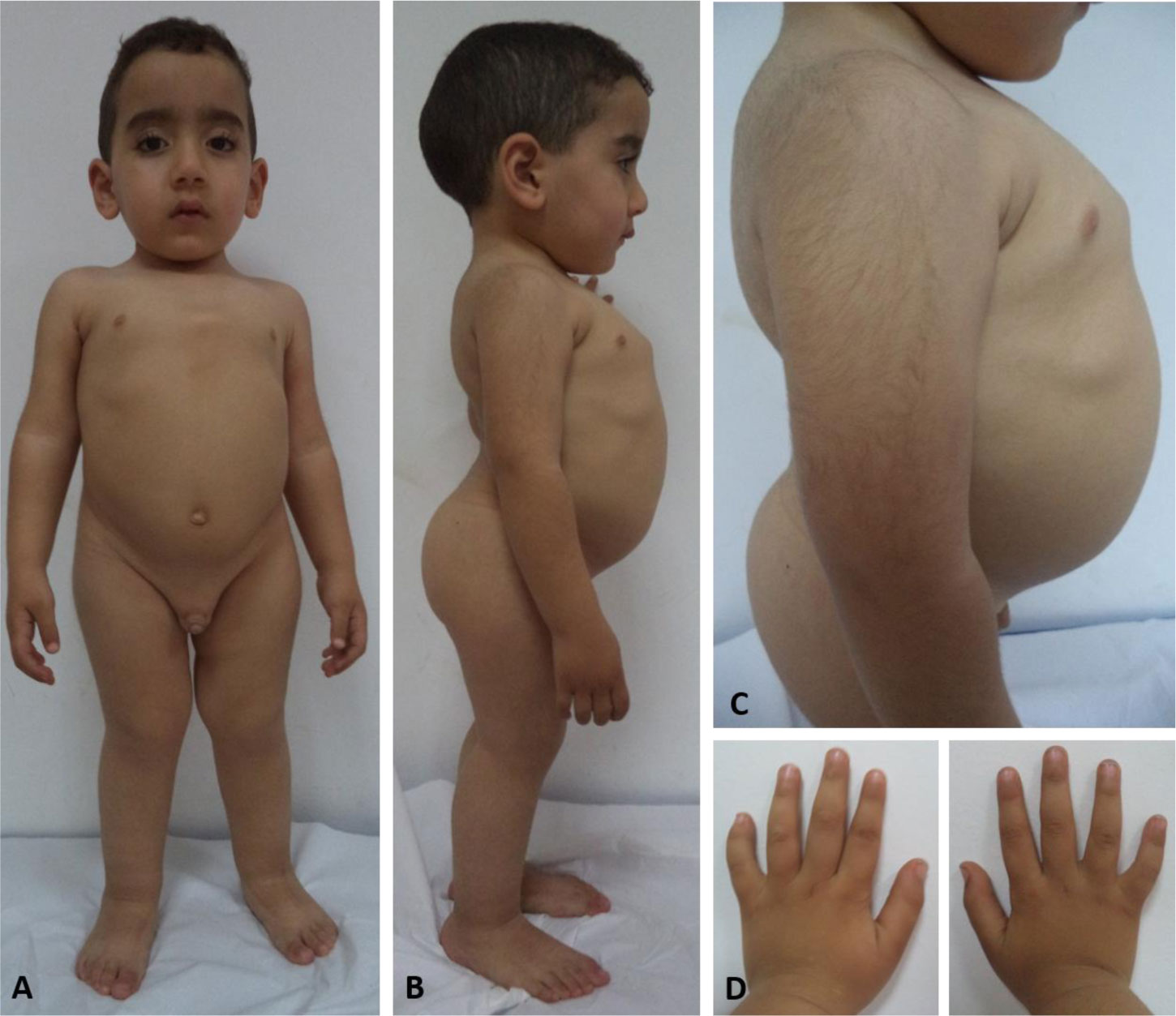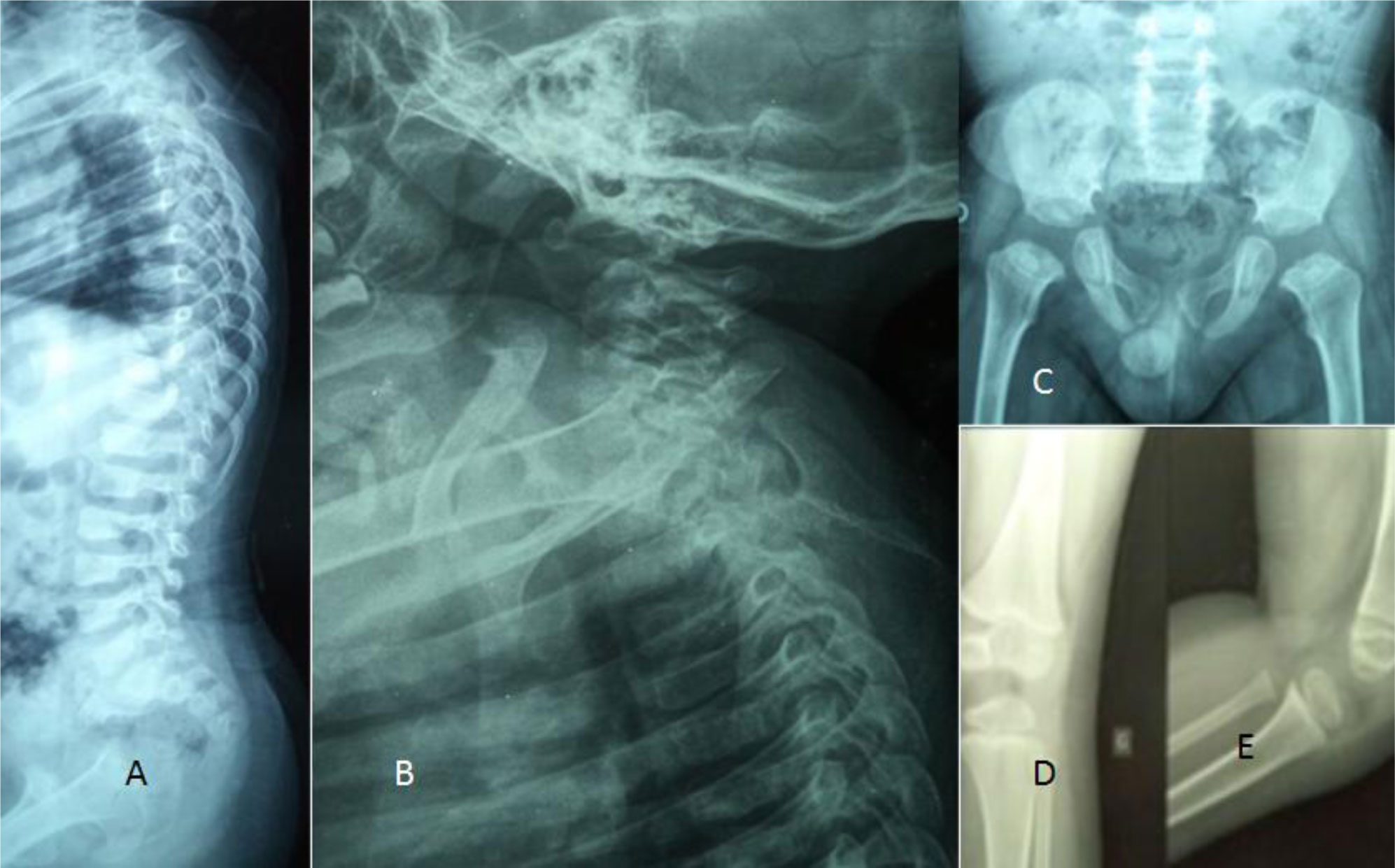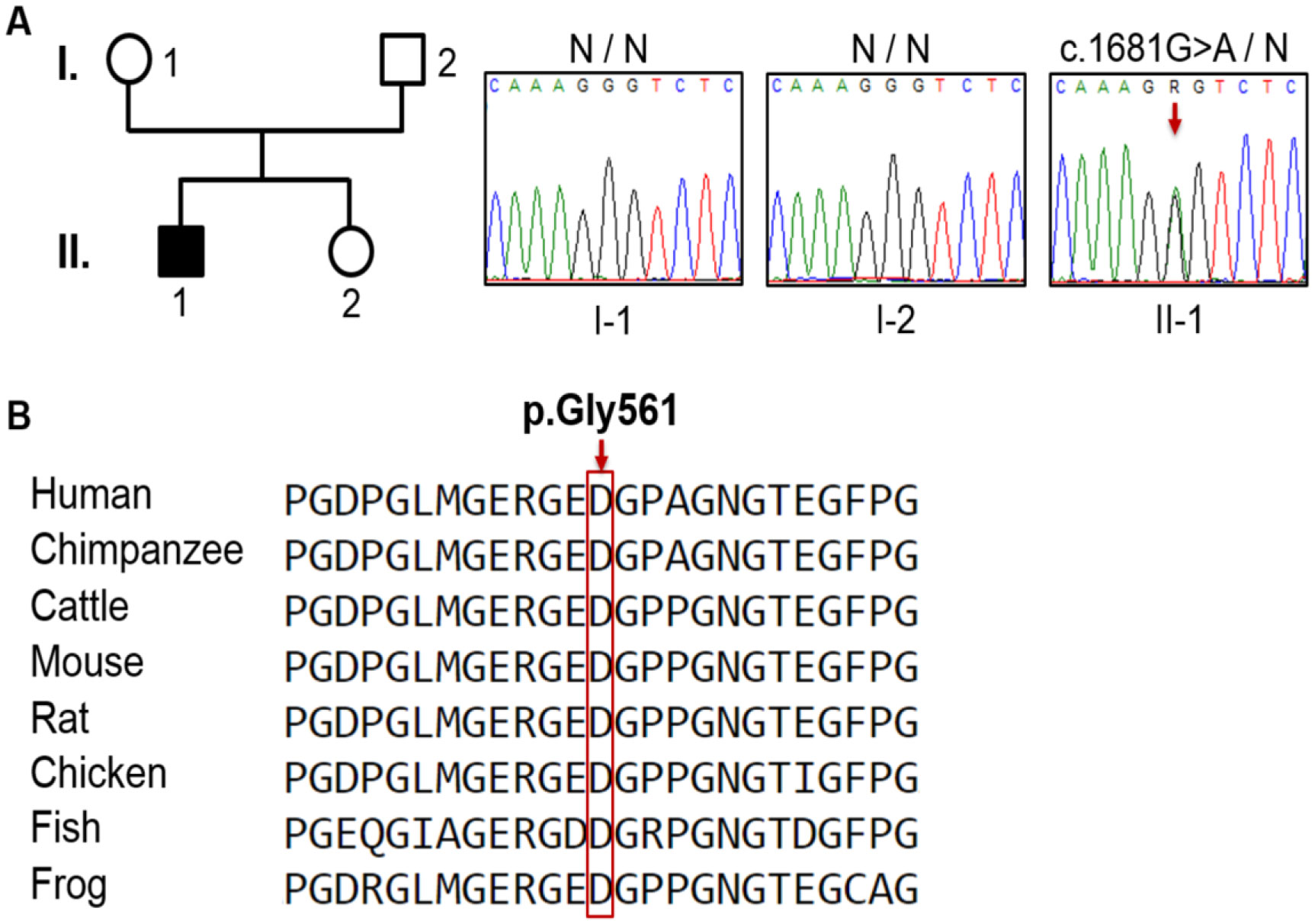1.
Introduction
Abnormalities of type II collagen result in skeletal dysplasias (the so-called “type 2 collagenopathies”), which form a wide spectrum of phenotypic severity. The unifying features are predominant involvement of the vertebral bodies and the epiphyses of the long bones (“spondylo-epiphyseal” pattern). These disorders are clinically characterized by different serious craniofacial and skeletal abnormalities as well as visual or hearing impairment [1],[2]. Although the current classification is based on severity, distinctive skeletal abnormalities and radiographic differential signs, the clinical variability and phenotypic overlap in these disorders are frequently observed in patients, even within the same family [3]–[6]. Collagenopathies type II are caused by heterozygous mutations in the collagen type II alpha-1 gene (COL2A1, OMIM 108300). COL2A1 gene is located on chromosome 12q13, consists of 54 exons, spanning over 31.5 kb, and encodes a 1487-amino acid collagen type II protein, which is crucial for constructing functional collagen [5],[7],[8].
2.
Material and methods
2.1. Whole exome sequencing and bioinformatics analysis
Whole exome sequencing for the proband was performed on Ion Proton instrument (Life Technologies, Carlsbad, CA, USA) according to the manufacturer's instructions. Sequence reads were aligned to the human reference genome UCSC version hg19 (build 37), using Torrent Mapping Alignment Program (TMAP) from the Torrent Suite (v5.0.2). The variants were called using the Torrent Variant Caller (TVC) plugin (v5.0.2), and were annotated with the associated gene, location, quality-score, and coverage. Common SNPs reported in the NCBI database [9] and the Exome Sequencing Project [10] were filtered out as described before [11]. We removed variants that were present in greater than 1% of the previously 634 in-house sequenced samples. Variations were verified using online databases: ClinVar [12], Leinden Open Variation Database [13], GnomAD [14],[15] and the Exome Agammaegate Consortium [16]. We used a combination of in silico predictive online software to study the effect of variations on amino-acids and protein structure thus to set its pathogenicity [17]. Sorting Intolerant From Tolerant SIFT [18], PolyPhen2 [19], Grantham score [20], and Mendelian Clinically Applicable Pathogenicity (M-CAP) score [21], phyloP conservation scores [22] and mutation taster [23].
2.2. Sanger sequencing
Sanger sequencing flanking the COL2A1 mutation was performed according to its sequence on GenBank and Ensembl databases. The wild-type COL2A1 sequence NM_001844.4, corresponding NP_001835.3, was used to set the variant nomenclature. Primers used for validating the causative COL2A1 variant in exon 26 were designed using Primer 3 software [24]. Forward: 5′-AGCCCGGGTAAGTAGCAGAG and Reverse: 5′-GCCTACCATCTACCCCCTGT. Capillary sequencing was performed in a 3730 DNA Analyzer (Applied Biosystems, Foster City, CA) and the data were analyzed using Sequencing Analysis Software.
3.
Results
3.1. Clinical/phenotypical descriptions
A-2-year-old boy was referred to our department because of marked growth deficiency, antalgic gait, and global developmental retardation in acquiring the motor, fine and communicative skills. He started to walk at the gas of 18 months albeit with difficulties. Family history was non-contributory. He was born at term via caesarean section for breech presentation with a birth weight of 3800 gm, length of 45 cm (−3 SD) and head circumference of 40 cm (> +2 SD). Birth and perinatal history were uneventful. Clinical examination revealed short stature of pre and postnatal onset (−3 SD), weight and the head circumference were around (+2 SD). He manifested dysmorphic craniofacial features of wide and bulging frontal area (tower like head), hypotelorism and upslanting palpebral fissures. In addition to synophrys, long eyelashes, anteverted nares, full cheeks and full cheeks and a barrel-shaped chest with thoracic kyphosis are also observed. Disproportionally long limbs in comparison to short trunk dwarfism, thoracic kyphosis, pectus carinatum associated with exaggerated lumbar lordosis. Examination of external genitalia revealed small penis associated with unilateral cryptorchidism (Figure 1A) Lateral view showed normal limbs length, exaggerated lumbar lordosis, short trunk dwarfism and protuberant abdomen (Figure 1B). Hypertrichosis of the back and the arms were notable features (Figure 1C). Hands are stubby with clinodactyly of the fifth fingers (Figure 1D). Musculo skeletal examination showed reduced hips range of motion (ROM) (abduction of 40 degrees, adduction of 20, internal rotation of 40 and external rotation of 45 bilaterally). In this child the waddling gait has been developed because of the dysplastic hips, the iliopsoas rested directly against the anterior dysplastic capital femoral epiphyses. The dysplastic capital femoral epiphyses act as secondary dynamic stabilizer causing effectively abnormal painful gait.
Skeletal survey, lateral spine radiograph showed platyspondyly of the lumbar vertebrae with spondylolisthesis of the 5th lumbar vertebra (Figure 2A). Lateral cervical and upper thoracic showed odontoid hypoplasia associated with massive compression of the cervical vertebrae (Figure 2B). AP pelvis radiograph showed marked epiphyseal dysplasia of the capital femoral epiphyses associated with acetabular dysplasia (Figure 2C). AP and lateral knee radiographs showed epiphyseal dysplasia and bifidity of the inferior femoral epiphysis (Figure 2D and 2E).
No associated hyper-functioning endocrinopathies such as hyperthyroidism, or excess growth hormone. Urine mucopolysaccharides were normal. GH (growth hormone) test was positive with values <5 ng/mL, indicating injections of GH, which could not be administered due to the low socioeconomic status of the family. Laboratory investigations have been summarized in Tables 1 and 2.
3.2. Molecular findings
The average read length was 192 bp and the average coverage of 110X, was achieved across the exome with 67% of bases covered at least 20X. A total of 6,495 variants were identified across protein-coding exons, UTRs, splice sites and flanking introns, including 886 homozygous, 3434 heterozygous and 2177 compound heterozygous.
Among these variants, a heterozygous missense mutation, 12-48379370-C-T; c.1681G>A; p.Gly561Ser within exon 26 of COL2A1 (NM_001844.5) gene was identified in the affected child. This variant results in a glycine to serine substitution in the triple helical domain of the type II procollagen chain. Sanger sequencing confirmed the de novo variant (Figure 3A). The glycine at position 561 is highly conserved among various species (Figure 3B). In silico analyses demonstrated that this variant is probably damaging and disease-causing mutation in the family.
4.
Discussion
Disorders arising from heterozygous mutations of COL2A1 are collectively termed collagenopathies. These are related to a long list of osteochondrodysplasia such achondrogenesis, Czech dysplasia, hypochondrogenesis, Kniest dysplasia, platyspondylic lethal skeletal dysplasia, spondyloepimetaphyseal dysplasia, Strudwick type, spondyloepiphyseal dysplasia congenita and spondyloperipheral dysplasia [6],[26]. The type II collagenopathies are charecterized by clinical heterogeneity with diverse human disorders associated with at least 405 mutations reported in COL2A1 gene [4]. Missense mutations are frequently responsible of chondrodysplasia phenotype with short stature. The majority of reported COL2A1 mutations were glycine substitutions affecting the triple helix domain with a dominant negative effect [27],[28].
The p.Gly561Ser was reported earlier by another group [27], which may impair protein stability and lead to dysfunction of type II collagen. The glycine residues in the repeating Gly-X-Y triplet are highly conservative, in which the substitution of glycine with bulkier amino acids generally destabilized the helical protein structure, and thus proper function of the protein, leading to the disorder and diverse phenotypic outcomes [29]. The patient of (SEDC) phenotype were found to be associated with the p.Gly561Ser mutation [27].
Husar-Memmer et al. [29] described severe polyarticular osteoarthritis in young patient in connection to a heterozygous mutation in COL2A1. Al Kaissi et al. [30] described a missense mutation, c.1636G>A (p.Gly546Ser), in a girl manifesting collagenopathy type II with hip dysplasia and spinal osteochondritis (Sheuermann's disease). On the other hand, Chen et al. [31] has reported the same mutation in a Chinese family but the phenotype was different.
Anderson et al. [32] described an autosomal recessive condition resembling spondyloepiphyseal dysplasia congenita in the first 3–5 years of life. This condition affects the spine and both the epiphyses and metaphyses at the ends of long bones in the arms and legs.
In the current study, we described a de novo mutation of the COL2A1 that changed the glycine residues in the (Gly-X-Y) triple helix of the alpha-1 (II) chains. The c.1681G>A mutation resulted in substitution of the conserved glycine to serine (p.Gly561Ser). The glycine to serine substitution mutation are frequently associated with a growth ranging (−1; +1 SD) which was inconsistent with our proband whose weight, head circumference and height were not within this range [28]. This mutation was previously reported once in a French patient with spondyloepiphyseal dysplasia congenita (SEDC) [27].
The proband's phenotype was inconsistent with Strudwick type of spondylometaphyseal dysplasia, but resembeling spondyloepiphyseal dysplasia congenita (SEDC). In other words, the extra-phenotypic features of our patient can be considered as part of the wide phenotypic spectrum of spondyloepiphyseal dysplasia congenita (SEDC) associated with a de novo pathogenic mutation c.1681G>A (p.Gly561Ser) in COL2A1 gene damaging type II collagen. The comparison of clinical characteristics of the proband to some of the type II collagenopathies is summarized in Table 3.
5.
Conclusions
We identified a de novo COL2A1 mutation (c.1681G>A) in a Tunisian family with skeletal dysplasia. Our findings may provide new insights for evaluating the phenotypic spectrum and variability of type II collagenopathies. The clinical and radiological phenotypic characterizations encountered in this child showed extra phenotypic features of cerebral, skeletal and genital malformations extending the phenotypic characterizations of spondyloepiphyseal dysplasia congenita (SEDC). The fundamental element in any proper orthopaedic management is the aetiological understanding. Thereby and on the one hand, we hope that our current study can encourage colleagues and particularly paediatric orthopaedic surgeons to dig deeper in order to comprehend the correlation between developmental abnormalities in children and genetically programmed disorders. On the other hand, it is mandatory to widen their knowledge in accordance with detectable clinical phenotype/genotype, especially when managing children manifesting a constellation of abnormalities.










 DownLoad:
DownLoad:





